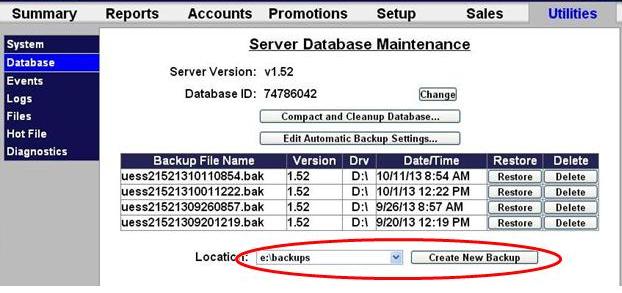
The Sierra® management system allows the user to back-up the server database either to the D drive or to a flash drive for off-site storage. Database back-up files can be used to restore operation of the system in the event of a catastrophic event. To minimize the potential for lost sales data, regular back-ups should be performed, preferably on a flash drive. The software version, date and time of previously created back-ups are displayed on the Database Utility screen on the Sierra management system.
NOTE: If you are backing up to an external flash drive (E:), you MUST create a folder called “backups” on that drive prior to performing the backup.
You can enable automatic back-ups or manually create backups.
To enable automatic backups on the Sierra management system, go to the Utilities tab at the top of the screen, then go to Databases in the left frame.

Click Edit Automatic Backup Settings.

A new daily backup will be generated at the selected time and will be shown on the main Database Maintenance screen.
To perform a manual backup on the Sierra management system, go to the Utilities tab at the top of the screen, then go to Databases in the left frame.

Select a backup location from the drop-down menu at the bottom of the table, then click Create New Backup.
NOTE: If you are backing up to an external flash drive (E:), you MUST create a folder called “backups” on that drive prior to performing the backup.

Click OK. Please note that no transactions should be in progress and that the units will restart when you click OK.
A new backup will be generated and will be shown on the main Database Maintenance screen.